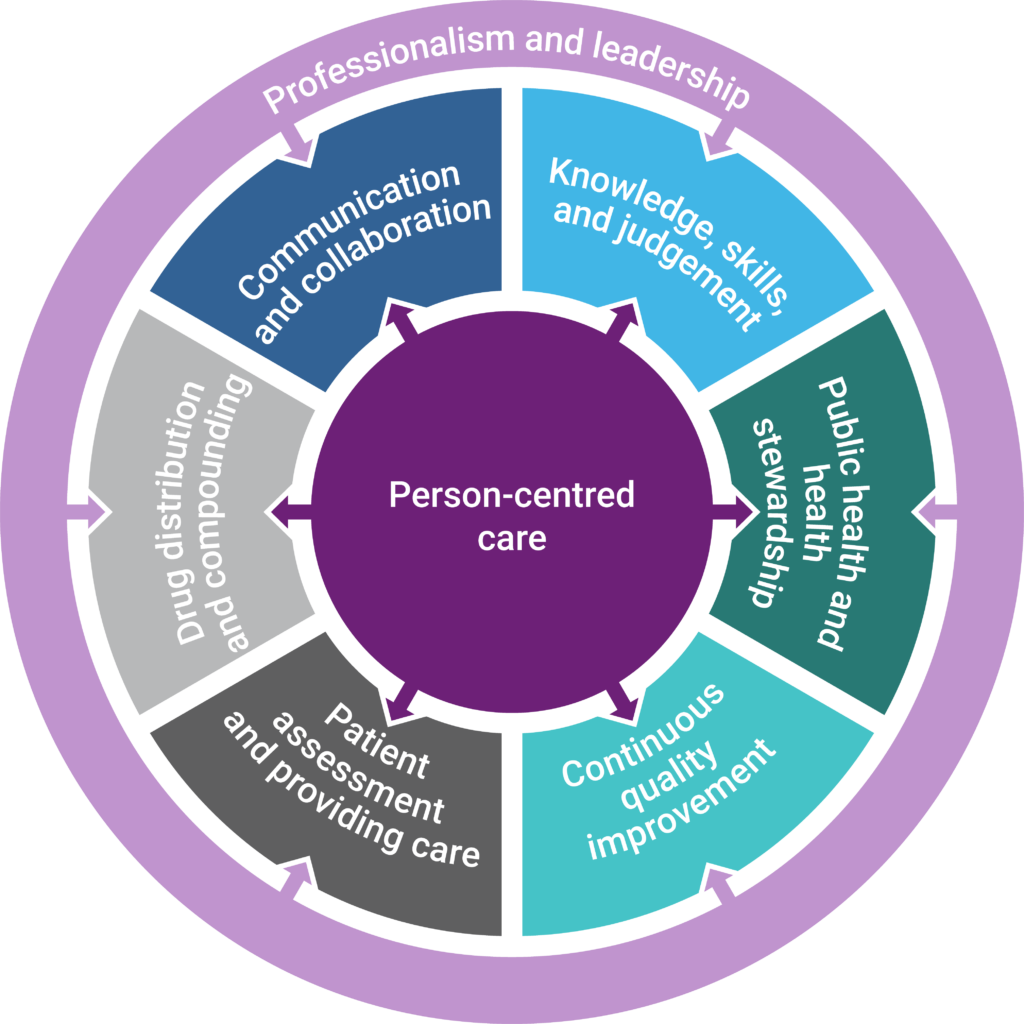
As pharmacists and pharmacy technicians prepare to implement the new Standards of Practice for Pharmacists and Pharmacy Technicians (SPPPT), which take effect on February 1, 2025, there are a number of key changes to consider. Following are some notable updates.
- New structure: Eight domains
The SPPPT are categorized into eight domains important to quality pharmacy practice. The domain of person-centred care is foundational to every aspect of pharmacy practice. Complementary to this, the domain of professionalism and leadership is fundamental to all activities that regulated members perform.
Each domain is divided into topics. Each topic has an outcome standard which describes the expected patient outcome that must be achieved for the standard to be met. The achievement of each outcome standard is detailed further by descriptive standards that provide specific details about the activities important to achieving the required outcome.

Learn more about the domains in The Link.
- Encompassing all regulated members at all practice sites
ACP’s current SPPPT came into effect in 2007, at which time only pharmacists were regulated. When pharmacy technicians became regulated health professionals in 2011, the standards were amended to include references to pharmacy technicians.
The roles of pharmacists and pharmacy technicians in the healthcare system have evolved significantly since the current standards were written and the new SPPPT reflect these changes. While some standards are directed at pharmacists or pharmacy technicians, the majority of the new standards are directed at “regulated members.” These standards apply to both pharmacists and pharmacy technicians and each profession is expected to apply the standards within the context of their role.
The new SPPPT do not focus on any particular type of practice site and are intended to support and direct regulated members regardless of where they practise pharmacy.
Learn more about applying the new standards to each role in The Link.
- Person-centredness sets the foundation (Domain 1)
Person-centredness is at the heart of the new SPPPT. It is the first of the eight domains of the new standards It influences the other seven domains, setting the foundation for every aspect of pharmacy practice.
Learn more about the concept of person-centred care in The Link.
- Incorporating equity, diversity, inclusion, and accessibility into practice (Domain 1)
A key element to successfully provide person-centred care is to incorporate the concepts of equity, diversity, inclusion, and accessibility. These concepts are prominent in the person-centred care domain of the new SPPPT. To provide person centred care also includes incorporating cultural sensitivity, mindfulness of Indigenous perspectives and culture, stigma minimization, trauma-informed care, and harm reduction into your practice.
Learn more about these concepts in The Link.
- Clarifying requirements for supervising unregulated pharmacy employees – critical steps and independent double check (Domain 2)
One of the significant changes in the new SPPPT is the removal of the concepts of direct supervision and indirect supervision. These have been replaced with the concept of identifying and communicating “critical steps” of any process that require an independent double check by a regulated member.
An unregulated employee, such as a pharmacy assistant, may complete certain steps of an activity to support patient care. However, each critical step performed by an unregulated employee requires an independent double check by a regulated member before the activity can proceed to the next step.
Learn more about changes to supervision requirements in The Link.
- Leadership and accountability demonstrated by regulated members (Standard 2.1)
Every regulated member plays an important role in contributing to an environment through which they provide quality care to patients. The new standards outline expectations for regulated members to work collaboratively, lead by example, hold themselves and others accountable, and overall adhere to a high standard of leadership and a culture of accountability.
- Collaboration with individuals within patients’ circles of care (Standard 3.3)
The definition of a patient’s circle of care has been expanded beyond regulated health professionals, to also include caregivers, and other individuals who work in collaboration with the patient and who are responsible for elements of providing or supporting their care. This includes individuals working with other community agencies and programs that are important to their care and social determinants of health. This team-based approach supports continuity of care.
- Collecting and responding to patient feedback (Standard 3.4)
The new standards address the regulated member’s responsibility to listen to, acknowledge, and respond to patient feedback and concerns. This includes creating an environment where each patient feels empowered to provide feedback and express concerns and the regulated member considers and appropriately responds to the concerns or feedback.
- Prioritizing evidence-informed decision making (Domains 4 and 7)
The new SPPPT set the expectation that regulated members use evidence-based information to make evidence-informed decisions. The new standards emphasize the importance of incorporating the best available evidence from research findings and clinical expertise along with patient preferences, values, and circumstances to inform decisions that are made with patients about their care.
Learn more about evidence-informed pharmacy practice in The Link.
- Defining what falls within the practice of a pharmacist’s or pharmacy technician’s profession (Standard 4.3.2 and 7.7.3)
The new standards prevent regulated members from holding themselves out as regulated members if they provide services that are not health services or that fall under the Personal Services Regulation. This includes administering injections for aesthetic purposes. The new Standards for the Operation of Licensed Pharmacies (Standard 4.13) also prevent licensees from allowing these services to be provided from a licensed pharmacy.
Learn more about new standards regarding the provision of personal services in The Link.
- Prioritizing public health and health stewardship (Domain 5)
As regulated health professionals, pharmacy technicians and pharmacists play an important role in public health and health stewardship. Domain 5 outlines regulated members’ roles in contributing to the health and safety of the community.
- Defining continuous quality improvement (Domain 6)
In fall 2024, ACP will launch a continuous quality improvement (CQI) program for Alberta pharmacy teams: CQI+. Building on ACP’s existing drug error management framework, this new program will enable the reporting of practice incidents and close calls to a central database to facilitate learning and sharing in the interest of patient safety.
Domain 6 defines the concepts of continuous quality improvement, safety culture, just culture, practice incidents, and close calls.
- Prioritizing patient assessment (Domain 7)
The current SPPPT have separate standards to address the activities that regulated members perform when providing care (e.g., dispensing medications, adapting prescriptions, prescribing medications, and administering injections).
In the new SPPPT, these activities are grouped together in one domain: Patient assessment and providing care. This new structure highlights the importance of always starting with a patient assessment. From this assessment, regulated members then determine appropriate next steps that may include dispensing, prescribing, providing an injection, or collaborating with others in the patient’s circle of care.
The new standards also emphasize the importance of deprescribing when conducting patient assessments and providing care.
Learn more about these concepts in The Link.
- Changes to age requirements for injections (Standard 7.7)
When the new SPPPT take effect, pharmacists with authorization to administer drugs by injection will be permitted to administer injections to individuals two years of age or older, provided the pharmacist has the appropriate training.
Currently, pharmacists are not permitted to administer an injection for a drug or vaccine to a child younger than five years of age. This change to two years of age or older was based on public need and a review of pharmacy regulators across Canada.
Pharmacists who wish to administer drugs and vaccines by injection to children between two and five years of age will need to successfully complete a Canadian Council on Continuing Education in Pharmacy (CCCEP) competency-mapped accredited immunization and injection program that includes content on administration to this age group. Learn more about what pharmacists need to know about age requirements for injections in The Link.
- Defining consent authorities (Appendix A)
The new standards define informed consent and, in Appendix A, outline who can provide consent.
Note that this is not a comprehensive list of changes. Regulated members must review the new SPPPT in their entirety to ensure preparedness and compliance.
For more information on the new SPPPT, refer to the standards page.




